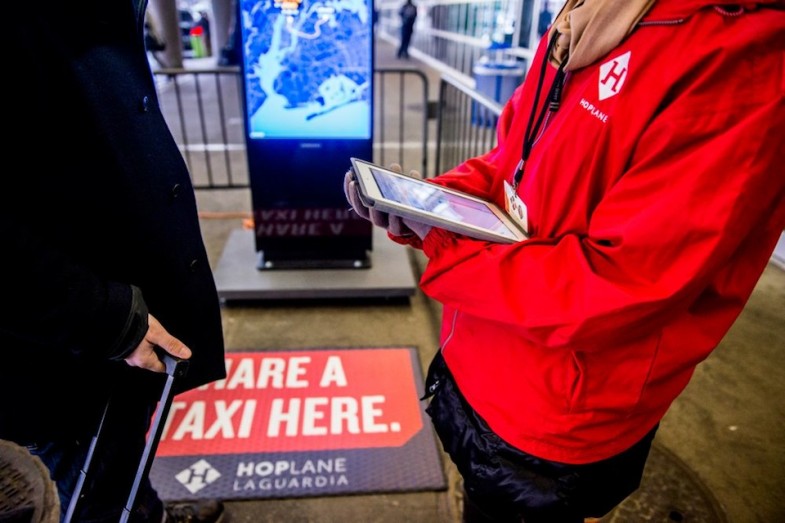With a palpable enthusiasm for collaboration, David Mahfouda is plotting a new future for taxi transportation in New York City—one that’s more cost-effective, more efficient, and more sociable. Bandwagon, Mahfouda’s new ride-share service that launched at LaGuardia Airport in July, fills underutilized capacity in taxis by matching passengers who have complementary destinations and getting them into the same cab. Drivers make a better fare, passengers pay less for the same distance they would travel alone, and the idea, if it catches on, will likely amount to enormous environmental advantages over time. Here he answers a few questions about his project. —Jessica Conrad
What inspired you to start Bandwagon?
When I was studying architecture and design, I became fascinated with cities, a paradigm of collaboration, and read a lot of Christopher Alexander, the folk architect who focuses on how people used to build and rebuild an environment. One of his driving design tenets is repair. When you empower people to have design authority, they can create really beautiful, intricate, and sensitive spaces over time through revision. Bandwagon emerged partly out of that ethic: Rather than create an entirely new taxi system, we could simply make the existing system more efficient and more social. The service also provides an answer to questions of space and mobility, which are inextricably intertwined in the U.S. If we can make the car more social, my hope is that we can make our public spaces and cities more social as well.
Can you walk me through a typical user experience?
There are two typical user experiences. The service is slightly different for someone leaving the airport versus someone headed there. Using Bandwagon to leave the airport, you would first need to get into a taxi line called the HOP lane, or high-occupancy passenger lane, which gives priority to people who are willing to reduce wait times for everyone else by sharing their ride. If you didn’t already have the Bandwagon app, you would download it and register your destination address, or, if you didn’t have a smartphone, you would give your destination address to the line manager. We have a board near the HOP lane where passengers can see every destination registered in the Bandwagon system. When we find you a match—someone with a complementary destination—your name will appear next to the other passenger’s name on the board. We also send an alert to your phone saying, “Jessica, we’ve found you a match. You can hop up the HOP lane.” At that point you would move to the front of the line where you would meet the other passenger and get into a taxi together. Right now faring is very informal—you split the fare as you would with a friend, the first passenger paying cash to the passenger who closes the tab with credit—but we’re working with the TLC to formalize the faring process. That way each passenger will be able to pay the driver directly for his or her portion of the ride. This improvement will be great for taxi drivers too, because the individual fares will be slightly higher than half. We think the drivers should be rewarded for reducing wait times for passengers and doing something good for the city and environment. The customer experience from the city to the airport is really straightforward. All you do to book a trip on Bandwagon is enter your itinerary and preferred pickup time via our website or mobile app, and we take care of the rest. If we have a match for you at the time of your booking, we tell you your expected pickup time, give or take 15 to 20 minutes to accommodate other passengers. If we don’t have a match for you, we book your ride anyway, and you receive a discount on your fare for your willingness to share. If someone joins your ride, we follow up, but if not, your ride is still booked either way. You get picked up as you normally would for a trip to the airport, except that there might already be a passenger in the vehicle or you might have to pick one up on the way. It’s that simple. 
What sets Bandwagon apart from other ride-share services, such as Lyft and Sidecar?
I love Lyft and Sidecar, they’re both great companies. What they do is deputize people with cars to be taxi drivers. And while I think there’s a need for their services, the more important and forward-thinking question to me is about how to use our existing physical resources and systems more effectively. In order to do that on the road, you need to use vehicles at capacity. That’s what we’re doing. We’re working with the industry to put multiple passengers in legal taxi and car services. It not only brings the price of these services down, but also increases the availability of these services. Plus, it’s better for the environment. Instead of putting additional taxi drivers on the road, we’re allowing existing resources to be more effective at serving the city.
As far as I understand it, the New York taxi system is highly regulated. How were you able to work into that system as a startup, especially given that so many other ride-share services have failed to do so?
We launched the service at LaGuardia Airport because we’re using Bandwagon to facilitate an existing sharing program of the TLC. They created shared taxi and limousine rates from LaGuardia to various parts of the city, but they didn’t build infrastructure to facilitate passenger matching. So we came to TLC with a product that would basically facilitate the policy they were already pursuing. As a result, we’ve been able to align ourselves with the industry. The other good thing is that we’re not really in conflict with anyone. When we put multiple passengers in car services, drivers make more money and passengers spend less money. With Bandwagon we’re opening up the market to more people, and, in doing so, we’re making the system more efficient. We’ve made a conscious effort to bring all the parties together around this new practice because we think it will be beneficial for everybody.
What has been your greatest challenge?
Everything has been a challenge. The logistical problem is similar to the political problem, which is similar to both the business problem and the financial problem. Everything is related. We have to try to get all the stakeholders on the same page and all the passengers where they want to go on time. On top of that, we’re trying to educate people about a new behavior. And while that’s challenging, it’s so valuable. Once people try taxi sharing, they really like it.








